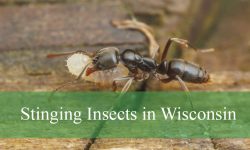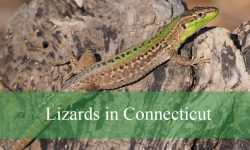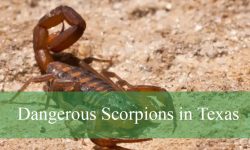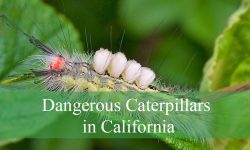Lizards in Oklahoma showcase remarkable diversity, ranging from fast-moving racerunners to secretive skinks and vibrant collared lizards. These reptiles thrive in prairies, woodlands, rocky outcrops, and even urban areas, each adapted to its environment.
Some species are small and elusive, blending into leaf litter or logs, while others, like the Eastern Collared Lizard and Broad-headed Skink, are noticeable for their size, striking colors, and distinctive behaviors. Observing them reveals the state’s rich reptile diversity.
This guide presents 19 lizard species found across Oklahoma, highlighting identifying features, size, behavior, habitats, and distribution. It provides detailed information for spotting and understanding these fascinating reptiles in the wild.
Types of Lizards Found in Oklahoma
Eastern Collared Lizard (Crotaphytus collaris)
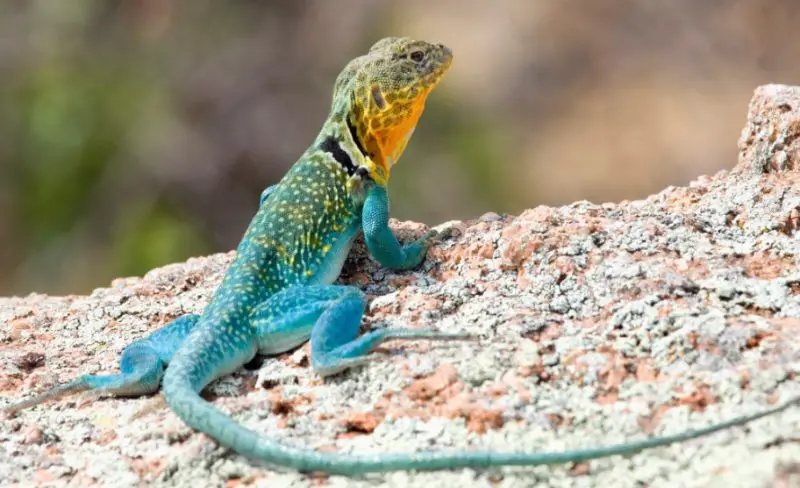
The Eastern Collared Lizard is a striking species known for its bold coloration and robust build. Adults typically measure 4 to 8 inches in body length, with males displaying bright green or turquoise bodies and distinctive black bands across their neck and shoulders, forming a “collar.” Females are slightly duller, with more muted greens and yellows, but still bear the characteristic black collar pattern. Their large, strong hind legs make them excellent sprinters, capable of running on their hind legs when startled.
These lizards are diurnal and highly territorial. They actively hunt insects, spiders, and small vertebrates, using a sit-and-wait ambush strategy or chasing prey with rapid bursts of speed. Eastern Collared Lizards are also known for their head-bobbing and push-up displays to communicate dominance or ward off rivals. During the hottest parts of the day, they may retreat into shaded rocky crevices to avoid overheating.
In Oklahoma, Eastern Collared Lizards are found primarily in rocky outcrops, limestone hills, and open woodlands, favoring areas with loose stones and sandy soil. Their distribution covers the western and central parts of the state, particularly in areas with sparse vegetation. These lizards thrive in environments that provide ample sun for basking and plenty of crevices for hiding from predators.
Greater Earless Lizard (Cophosaurus texanus)
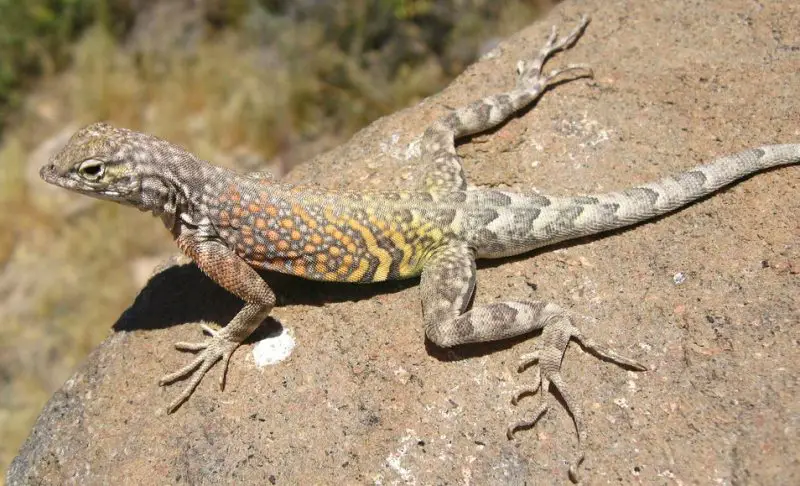
The Greater Earless Lizard is medium-sized, measuring about 4 to 6 inches long, and is notable for its lack of external ear openings, which gives it a smooth, streamlined appearance. Males exhibit vibrant green or blue-green dorsal coloration with reddish or orange highlights on the throat during breeding season, while females are generally more brownish and patterned with faint stripes for camouflage. Their long, slender tails aid in balance and quick directional changes while running across open terrain.
Behaviorally, this species is fast and skittish, often fleeing into cover at the first sign of danger. It is an opportunistic predator, feeding mainly on insects such as grasshoppers, beetles, and ants. Greater Earless Lizards are highly territorial, and males often perform push-ups and lateral body displays to assert dominance. They rely heavily on speed and agility for both hunting and escaping predators.
In Oklahoma, Greater Earless Lizards are primarily found in the western plains and sandy, arid regions. They prefer open, sparsely vegetated areas with loose soil or gravel, which facilitates rapid movement. Their distribution is patchy, often concentrated in regions where soil composition allows for easy digging and quick retreats into burrows.
Texas Horned Lizard (Phrynosoma cornutum)
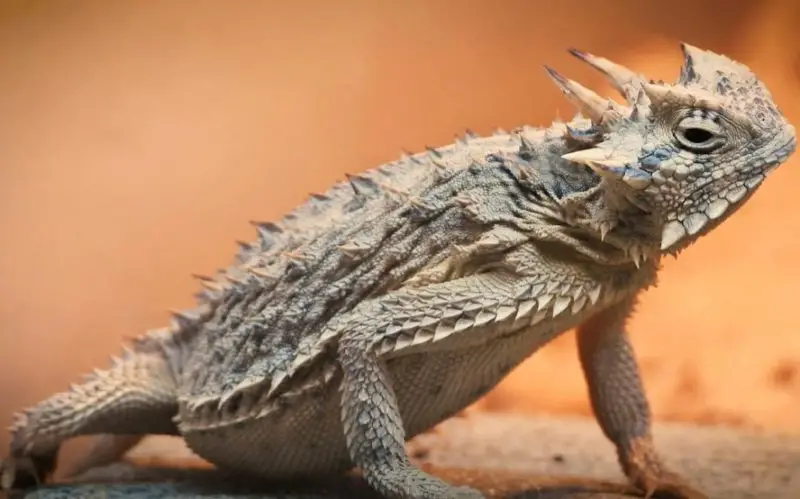
The Texas Horned Lizard is a stout, flattened lizard, measuring 4 to 5 inches long, easily recognized by its broad, spiny head and rows of horn-like scales along the body. Its coloration varies from tan to reddish-brown, often patterned with darker blotches that provide excellent camouflage against sandy and rocky backgrounds. Its spiny scales and ability to puff up its body make it less appealing to predators, while specialized blood-squirting behavior from the eyes serves as a last-resort defense mechanism.
This species is primarily insectivorous, with a strong preference for ants, especially harvester ants. Horned Lizards are slow-moving and rely on camouflage rather than speed, remaining motionless to ambush prey. They are diurnal and often seen basking on open ground or partially buried in sand to regulate body temperature. Mating displays involve subtle head movements and tail flicks rather than aggressive chases.
In Oklahoma, the Texas Horned Lizard inhabits sandy prairies, rocky outcrops, and areas with loose, well-drained soils. They are mostly found in the western and central regions of the state. Habitat destruction and pesticide use have contributed to population declines, making conservation of sandy and semi-arid habitats crucial for their survival.
Prairie Skink (Plestiodon septentrionalis)
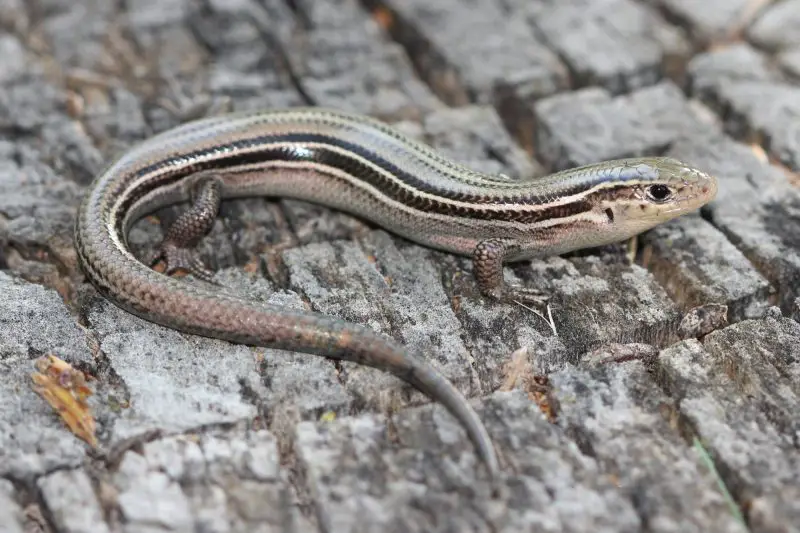
The Prairie Skink is a small, slender lizard, typically measuring 3 to 4 inches in body length with a long tail. Its dorsal coloration is brown to olive with subtle lateral stripes, while the ventral surface is lighter. Juveniles often have a bright blue tail, which fades with age, serving as a distraction to predators. Its smooth scales and streamlined body allow it to move quickly through grass and leaf litter.
Prairie Skinks are diurnal and feed primarily on insects, spiders, and other small invertebrates. They are secretive and prefer to remain hidden under rocks, logs, or leaf litter, emerging mainly to hunt or bask in sunlight. They reproduce via eggs laid in moist soil or under debris, with hatchlings emerging during the warmer months.
In Oklahoma, Prairie Skinks are widespread across prairies, open woodlands, and grassland edges. They favor areas with loose, well-drained soil and abundant ground cover for concealment. Their distribution spans the central and eastern parts of the state, where prairie habitats remain relatively intact.
Broad-headed Skink (Plestiodon laticeps)
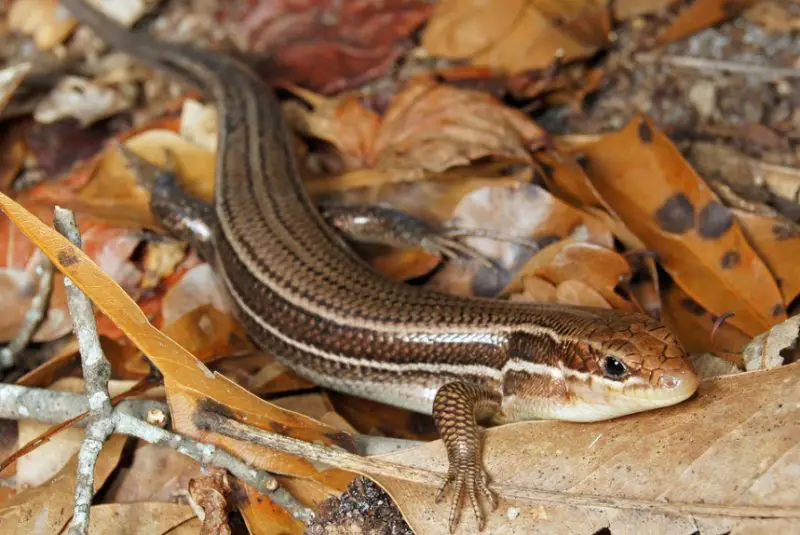
The Broad-headed Skink is a large, robust skink, growing up to 12 inches long, with males displaying broad, reddish-orange heads during the breeding season. The body is smooth and shiny, with dark brown or black scales marked by lighter stripes along the sides. Females and juveniles are smaller, with more subdued coloration, but the characteristic striped pattern along the back remains. Their strong, muscular tails are capable of autotomy, allowing escape from predators.
Broad-headed Skinks are active foragers, primarily consuming insects, spiders, and occasionally small vertebrates. They are excellent climbers, often ascending trees in search of prey or to bask on sunlit branches. Territorial interactions are common among males during the breeding season, involving head bobbing, push-ups, and chases. They are mostly diurnal but will seek shelter in tree cavities, logs, or leaf litter at night or during extreme heat.
In Oklahoma, Broad-headed Skinks are concentrated in the eastern forests, particularly in areas with abundant hardwoods, fallen logs, and dense undergrowth. They require moist environments with ample hiding spots and basking sites. This species’ presence is a good indicator of healthy, mature forest ecosystems.
Common Five-lined Skink (Plestiodon fasciatus)
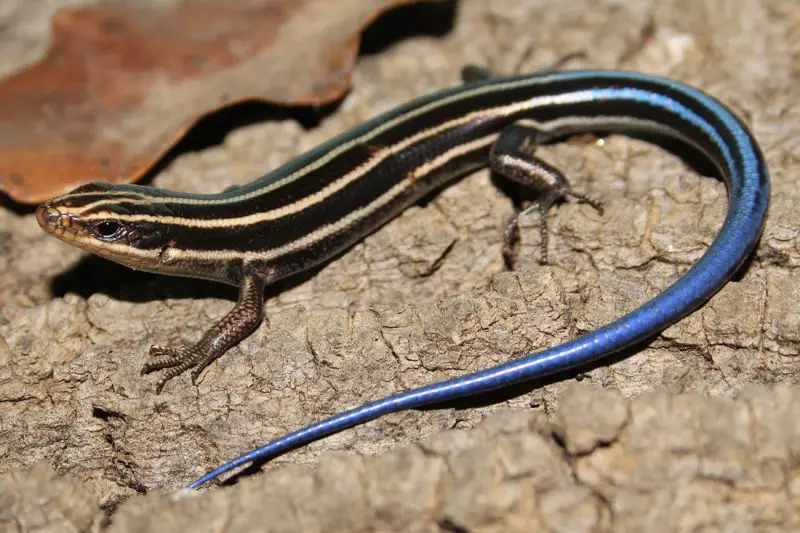
The Common Five-lined Skink is a medium-sized lizard, typically 4 to 7 inches long, with smooth scales and five distinctive pale stripes running from the head to the tail against a dark brown or black background. Juveniles are particularly striking, with bright blue tails that gradually fade with age. Males develop reddish-orange coloration on the head during the breeding season, while females remain more subtly patterned.
Behaviorally, these skinks are secretive and thrive in leaf litter, under logs, rocks, or forest debris. They are diurnal, feeding on insects, spiders, and other small invertebrates. The blue tail of juveniles acts as a decoy to divert predator attacks away from the more vulnerable body. These skinks are capable of rapid movement and tail autotomy to escape threats.
In Oklahoma, the Common Five-lined Skink is found primarily in moist, wooded areas in the eastern and southeastern parts of the state. They favor deciduous forests with abundant ground cover and consistent humidity. Their presence is an indicator of healthy forest floor ecosystems, where leaf litter and debris provide both food and shelter.
Coal Skink (Plestiodon anthracinus)
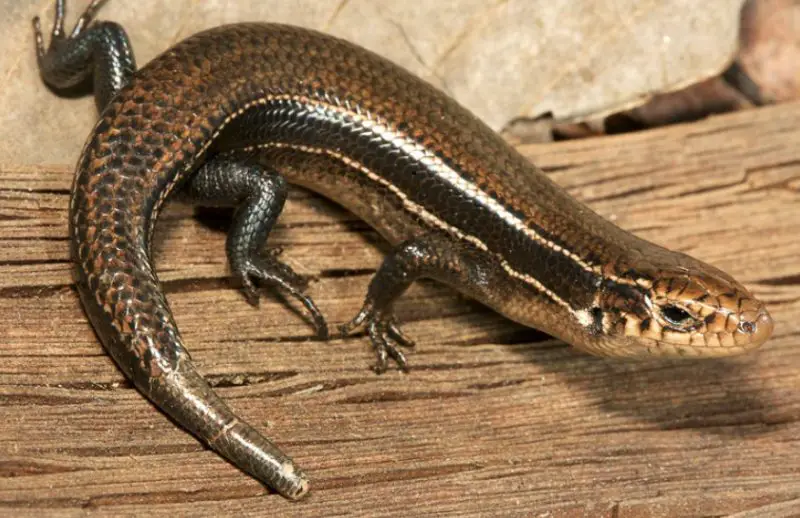
The Coal Skink is a small to medium-sized lizard, typically 3 to 5 inches in body length with a long tail. Its dorsal surface is dark brown to black with lighter stripes running along the sides, while the ventral surface is lighter, often pale gray or cream. Juveniles exhibit a bright blue tail, which fades as they mature. Their smooth, shiny scales allow them to move efficiently through leaf litter and under logs.
Coal Skinks are secretive and primarily insectivorous, feeding on ants, beetles, spiders, and other small invertebrates. They are diurnal but tend to stay hidden under rocks, logs, or dense vegetation. When threatened, they may remain motionless or quickly dart into cover. Breeding involves subtle courtship displays, and females lay eggs in moist soil or under debris.
In Oklahoma, Coal Skinks inhabit moist woodlands, creek edges, and shaded rocky areas, primarily in the eastern part of the state. They prefer habitats with abundant leaf litter, logs, and rocks that provide cover and foraging opportunities. Their populations are sensitive to habitat disturbance, especially in areas with deforestation or drainage changes.
Ground Skink (Scincella lateralis)
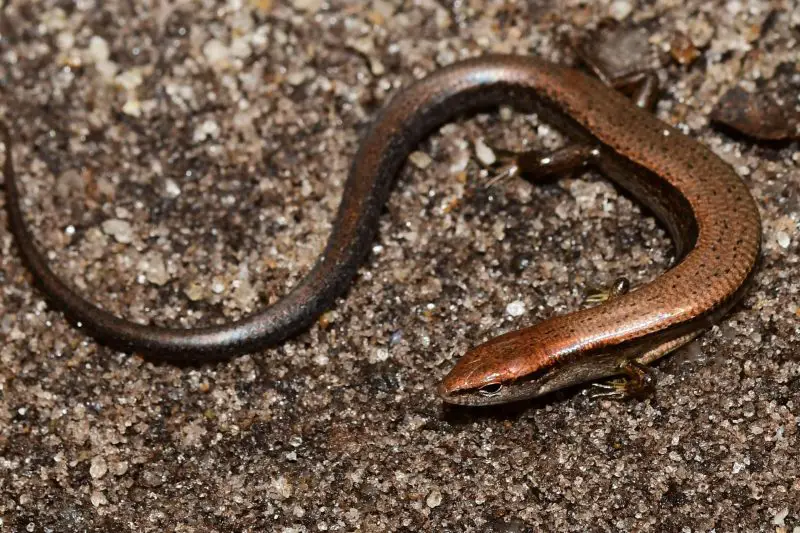
The Ground Skink is a small, slender lizard, usually measuring 2.5 to 4 inches in body length. Its dorsal surface is brown with subtle longitudinal stripes, while the underside is lighter, ranging from pale yellow to cream. Juveniles have a more pronounced blue tail, which gradually fades with age. Its small, smooth body allows it to navigate easily through leaf litter and soil surface debris.
This species is highly secretive and primarily insectivorous, feeding on ants, termites, and small arthropods. Ground Skinks are diurnal but rarely seen due to their tendency to remain hidden under leaves, logs, and rocks. They reproduce by laying eggs in moist soil or decaying vegetation, with hatchlings emerging in warmer months. They are quick and capable of rapid retreats when disturbed.
In Oklahoma, Ground Skinks are widespread across the eastern forests and wooded areas. They prefer moist, shaded environments with abundant ground cover and leaf litter. Their distribution overlaps with other forest floor skinks, making them an important component of the woodland ecosystem.
Ornate Tree Lizard (Urosaurus ornatus)
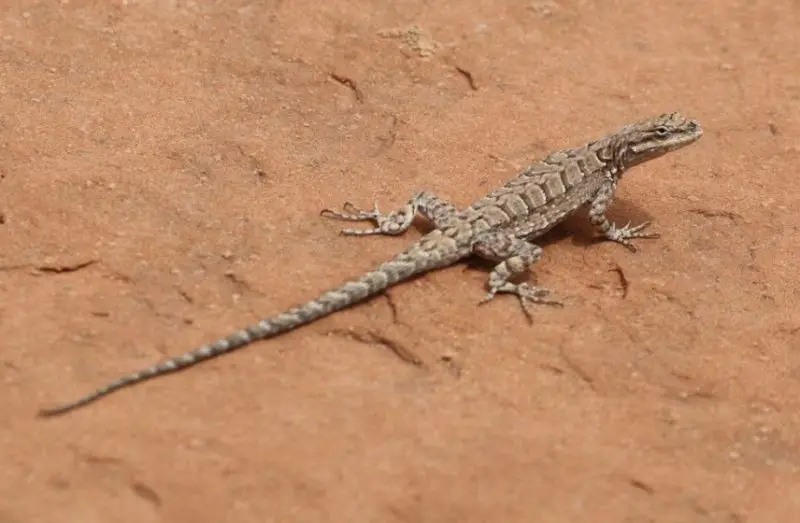
The Ornate Tree Lizard is a small, agile lizard, measuring 3 to 5 inches in total length. It is known for its variable coloration, which can include gray, brown, or olive with dark mottled patterns along the back. Males often develop bright blue or orange markings on the throat and belly during the breeding season. Their flattened bodies and long tails allow them to climb rocks, tree trunks, and shrubs with ease.
Ornate Tree Lizards are diurnal and primarily insectivorous, feeding on ants, beetles, and other small invertebrates. They are territorial and communicate through visual displays such as push-ups, head bobbing, and tail flicks. These lizards often bask on exposed branches or rocks, retreating into crevices or vegetation when threatened. Breeding occurs in spring and summer, with females laying eggs in protected locations.
In Oklahoma, Ornate Tree Lizards are found in the western and central regions, favoring rocky outcrops, arid scrublands, and open woodlands. They prefer habitats with ample climbing surfaces and sun-exposed perches, which allow them to thermoregulate and hunt efficiently. Their distribution is patchy and closely linked to suitable microhabitats.
Little Brown Skink (Scincella caudaequinae)
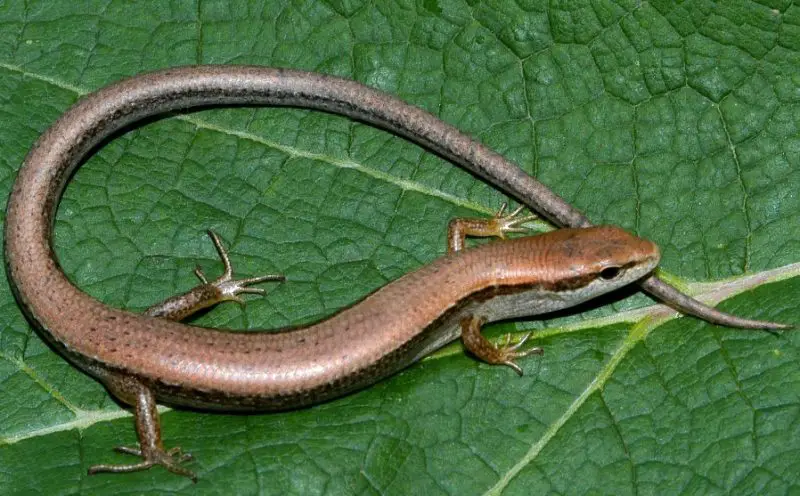
The Little Brown Skink is a very small, slender lizard, typically 2 to 3.5 inches long, with smooth, shiny scales. Its coloration is uniformly brown to tan, with subtle lighter striping along the sides. Juveniles have slightly brighter tails, which fade with age. Its tiny size and smooth body make it adept at moving through leaf litter, soil, and decaying wood.
This species is highly secretive and primarily insectivorous, feeding on ants, mites, and other small arthropods. It is diurnal but rarely seen because it spends most of its time under debris or buried in leaf litter. Breeding involves the female laying small clutches of eggs in protected, moist locations. They rely on speed and camouflage to avoid predation.
In Oklahoma, Little Brown Skinks are found mainly in the moist, shaded forests of the eastern and southeastern parts of the state. They prefer dense ground cover, leaf litter, and areas near small streams or damp soil. Their populations are sensitive to habitat loss and forest floor disturbance.
Western Slender Glass Lizard (Ophisaurus attenuatus)
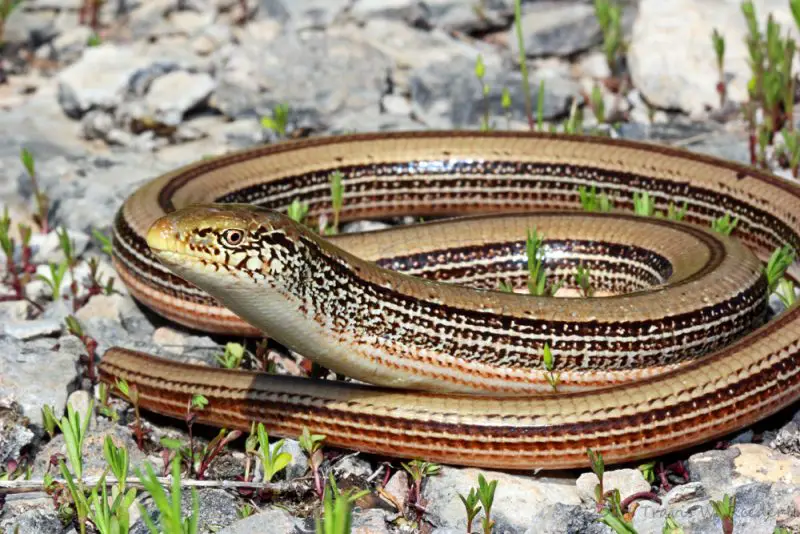
The Western Slender Glass Lizard is a legless lizard that resembles a snake, measuring 18 to 30 inches in total length. Its body is smooth and cylindrical, with a brown to gray dorsal surface and lighter ventral side. They have small, barely visible scales along the body and a long, brittle tail that can break off easily to distract predators. Their eyes and ear openings distinguish them from snakes.
Western Slender Glass Lizards are diurnal and primarily feed on insects, spiders, small lizards, and occasionally eggs. They are secretive, often hiding under debris, grass, or leaf litter during the day. They reproduce by laying eggs in soil or under logs, with hatchlings emerging in the warmer months. Their movement is serpentine, allowing them to navigate through grass and loose soil efficiently.
In Oklahoma, Western Slender Glass Lizards are found in prairies, open woodlands, and sandy soils, primarily in the western and central parts of the state. They prefer habitats with loose soil, ground cover, and minimal human disturbance. Their populations are vulnerable to habitat fragmentation and intensive land use.
Eastern Slender Glass Lizard (Ophisaurus ventralis)

The Eastern Slender Glass Lizard is another legless lizard, growing 15 to 25 inches in total length. It has a smooth, glossy body, with dorsal coloration ranging from brown to olive and a lighter cream-colored belly. Like other glass lizards, its tail can break off easily when threatened. It is often mistaken for a snake but can be distinguished by its small movable eyelids and external ear openings.
Eastern Slender Glass Lizards are insectivorous and feed on insects, spiders, and small vertebrates. They are secretive and spend much of their time hidden in tall grasses, leaf litter, or under logs. They are diurnal and use their elongated bodies to burrow or slither through vegetation. Females lay eggs in moist, protected soil, and juveniles hatch fully formed.
In Oklahoma, Eastern Slender Glass Lizards are primarily found in the eastern and southeastern forests and grasslands. They favor habitats with dense ground cover, loose soil, and abundant leaf litter. Their presence indicates healthy, undisturbed habitats with sufficient hiding spots and prey availability.
Western Fence Lizard (Sceloporus occidentalis)
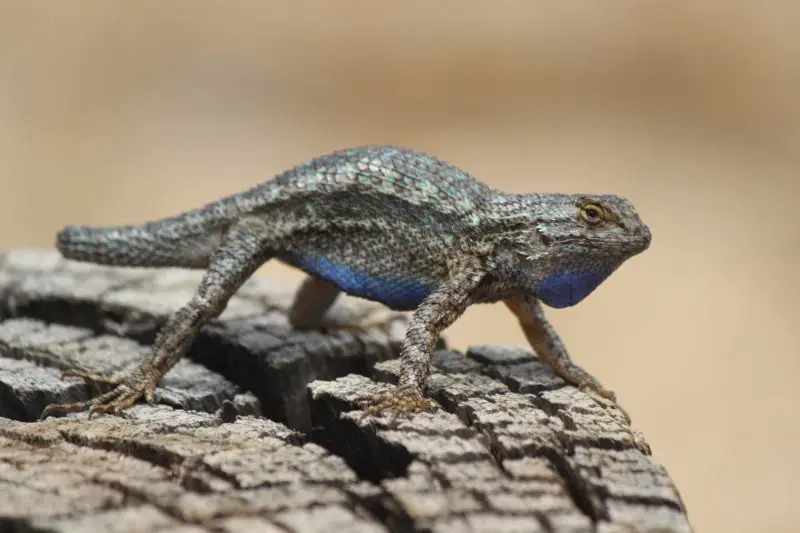
The Western Fence Lizard is a medium-sized lizard, typically 5 to 7 inches long, with rough, keeled scales and a distinctive blue throat and belly in males. Females and juveniles are generally brown or gray with faint striping. Its robust body and strong limbs make it an adept climber, often seen on rocks, logs, or fence posts.
These lizards are diurnal and primarily insectivorous, feeding on ants, beetles, and other small arthropods. They are territorial and use push-ups and head-bobbing displays to establish dominance. When threatened, they flatten their bodies against the surface to appear larger and may retreat quickly to nearby cover. Breeding occurs in spring, and females lay clutches of eggs in sandy or loose soil.
In Oklahoma, the Western Fence Lizard is rare and mostly found in the westernmost parts of the state. It prefers open woodlands, rocky outcrops, and areas with ample sun for basking. Its limited distribution is largely due to habitat preference and competition with more common local lizard species.
Southern Prairie Lizard (Sceloporus consobrinus)
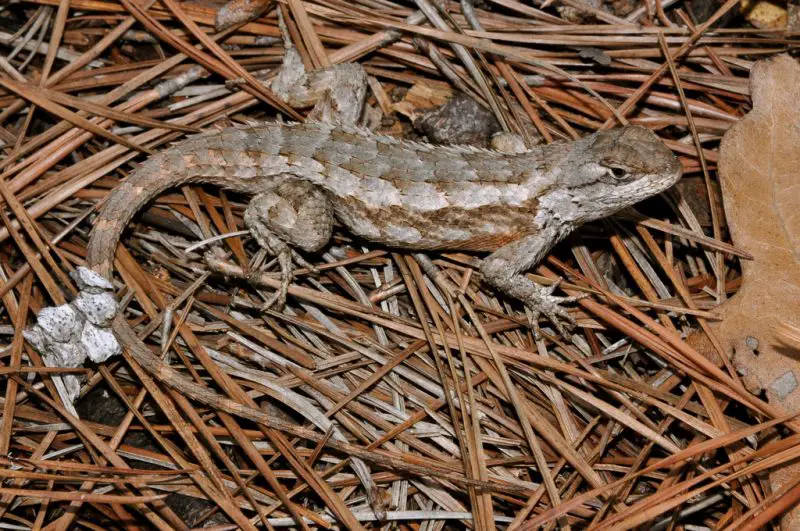
The Southern Prairie Lizard is a small to medium-sized lizard, measuring 4 to 6 inches in total length. It has rough, keeled scales, and males display bright blue patches on the throat and belly during the breeding season, while females remain more muted in brown and gray tones. Its body is slender but muscular, allowing quick sprints across open prairie terrain.
These lizards are highly active during the day and feed on a variety of insects, spiders, and other small invertebrates. They are territorial and communicate through visual displays such as head-bobbing and push-ups. Breeding occurs in spring, with females laying eggs in loose soil or sand. They are agile and capable of rapid retreats to avoid predators.
In Oklahoma, Southern Prairie Lizards are found throughout central and western prairies and open grasslands. They prefer areas with sparse vegetation and exposed soil for basking and hunting. Their populations thrive in natural prairie habitats that are not heavily disturbed by agriculture or development.
Green Anole (Anolis carolinensis) – introduced species
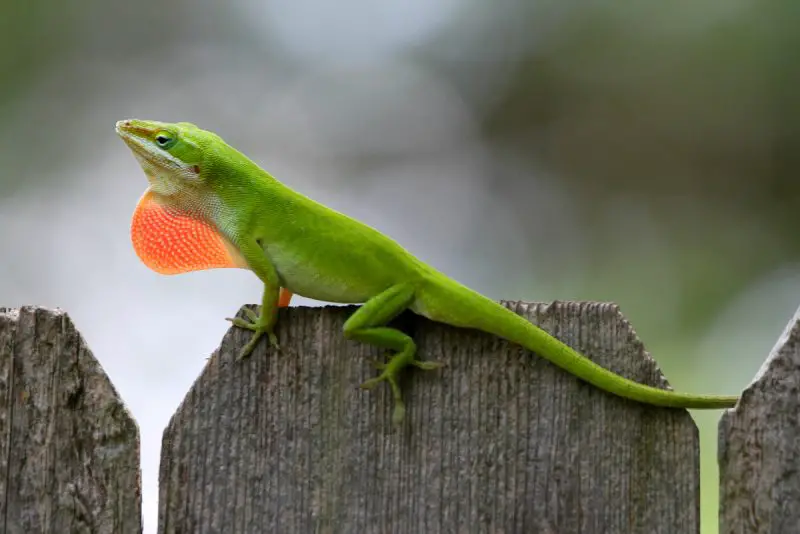
The Green Anole is a small, slender lizard, typically 5 to 8 inches long, with a bright green coloration that can change to brown under stress or environmental conditions. Males have a distinctive pink dewlap used for courtship and territorial displays. Its long tail and sticky toes allow it to climb vegetation with ease.
Green Anoles are diurnal and primarily insectivorous, feeding on small insects and spiders. They are territorial and use head-bobbing, dewlap displays, and push-ups to communicate. They reproduce in warm months, laying eggs in moist soil or leaf litter. This species is highly adaptable and can thrive in a variety of urban and suburban environments.
In Oklahoma, the Green Anole is an introduced species, found mostly in southern areas with gardens, parks, and other human-modified habitats. They compete with native lizards for resources but are generally limited by colder winters, restricting their permanent range.
Six-lined Racerunner (Aspidoscelis sexlineata)
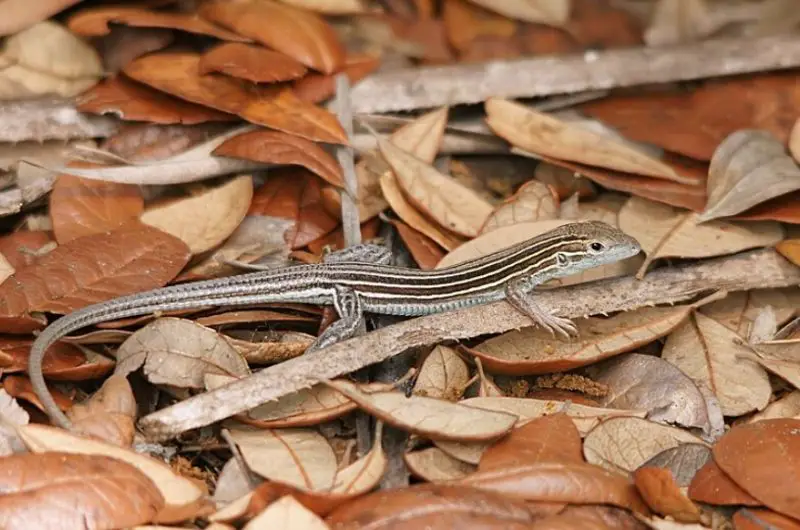
The Six-lined Racerunner is a medium-sized, fast-moving lizard, measuring 4 to 7 inches in body length. Its dorsal surface is olive to brown with six distinctive yellow stripes running from head to tail, while the ventral surface is pale. Juveniles have bright blue tails that fade with age. Its long legs and slender body enable rapid sprinting across open terrain.
These lizards are highly active, diurnal hunters, preying on insects, spiders, and other small invertebrates. They are territorial and exhibit head-bobbing and tail-waving behaviors during interactions with rivals. Breeding occurs in spring, with females laying eggs in sandy or loose soil. They rely on speed to escape predators rather than camouflage.
In Oklahoma, Six-lined Racerunners are found in central and western grasslands, open woodlands, and sandy areas. They prefer open, sunny habitats where they can bask and hunt efficiently. Their populations are generally stable, provided their habitat remains intact.
Western Six-lined Racerunner (Aspidoscelis sexlineata viridis)
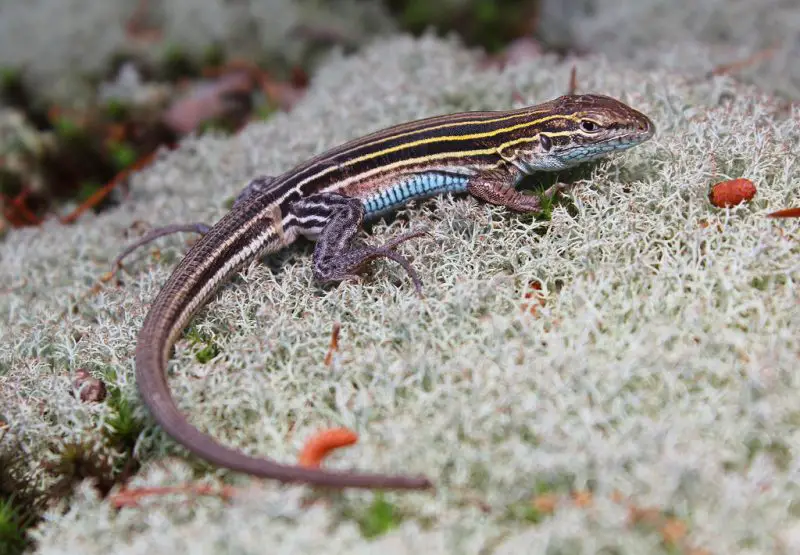
The Western Six-lined Racerunner is a subspecies of the Six-lined Racerunner, similar in size and shape, measuring 4 to 7 inches long. Its coloration is olive to greenish with six yellow stripes running along the back, and juveniles possess bright blue tails. Males develop more vivid colors during the breeding season. This subspecies has slightly longer limbs and a leaner body compared to the eastern counterparts, adapted for rapid movement on sandy soils.
Western Six-lined Racerunners are diurnal, feeding on insects, spiders, and other small invertebrates. They are extremely fast and rely on sprinting to evade predators. Territorial displays involve head-bobbing, tail flicks, and push-ups. Females lay eggs in loose, well-drained soil during the warmer months.
In Oklahoma, this subspecies is primarily found in western prairies and sandy areas, where it inhabits open terrain with minimal vegetation. They are adapted to dry, sun-exposed habitats and are seldom found in heavily forested or urbanized areas.
Checkered Whiptail (Aspidoscelis tesselata)
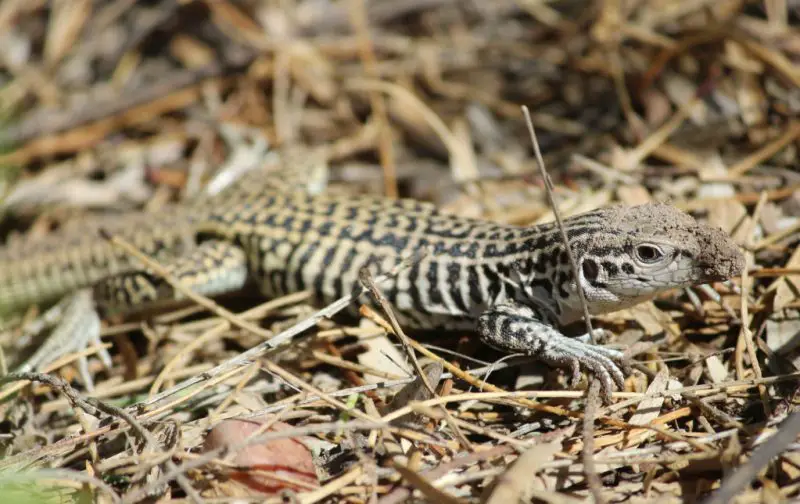
The Checkered Whiptail is a slender, medium-sized lizard, measuring 6 to 9 inches long. Its body is covered in dark brown or black checkered patterns on a lighter tan or gray background, and the tail is long and whip-like. Juveniles have brighter coloration, which fades as they age. Its smooth, elongated body allows for agile and rapid movement across grasslands and open areas.
These lizards are highly active, diurnal hunters, feeding on insects, spiders, and other arthropods. They are extremely fast and rely on speed to escape predators. Reproduction involves laying eggs in loose soil, with hatchlings emerging fully formed. They are social to some extent, with multiple individuals often foraging in proximity but still maintaining personal territories.
In Oklahoma, Checkered Whiptails are found in western prairies, open grasslands, and sandy soils. They prefer sun-exposed habitats with sparse vegetation and loose soil for burrowing and egg-laying. Their populations are stable where natural prairie habitats remain undisturbed.
Little Striped Whiptail (Aspidoscelis inornata)

The Little Striped Whiptail is a small, slender lizard, measuring 4 to 6 inches long. Its body is tan to brown with faint, narrow stripes running from head to tail. Juveniles may have slightly brighter coloration, while the tail is long and whip-like. Its streamlined body and long legs make it an adept sprinter, capable of rapid bursts of speed across open ground.
Little Striped Whiptails are diurnal and insectivorous, feeding on ants, beetles, and other small invertebrates. They are highly alert and use speed and agility to evade predators. Reproduction occurs in spring and early summer, with females laying eggs in sandy or loose soil. These lizards are often found in small groups, foraging together while remaining vigilant.
In Oklahoma, Little Striped Whiptails inhabit central and western prairies, sandy flats, and open grasslands. They prefer open, sun-exposed areas with minimal vegetation, which allows them to hunt efficiently and evade predators. Their populations are dependent on intact prairie habitats and loose, well-drained soils.
FAQs About Lizards in Oklahoma
What types of lizards are commonly found in Oklahoma?
Oklahoma is home to a variety of lizard species, including skinks, collared lizards, horned lizards, racerunners, whiptails, and introduced species like the Green Anole. Some of the most frequently encountered species are the Eastern Collared Lizard, Prairie Skink, Broad-headed Skink, Southern Prairie Lizard, and Six-lined Racerunner. Habitats range from prairies and woodlands to rocky outcrops and sandy soils.
Are any lizards in Oklahoma venomous?
No, lizards in Oklahoma are not venomous. While some species may bite if threatened, their bites are harmless to humans. Their primary defense mechanisms include camouflage, rapid movement, tail autotomy (dropping their tail), or in some cases, puffing up or squirting blood, as seen in the Texas Horned Lizard.
Which lizards are rare or introduced in Oklahoma?
The Western Fence Lizard is considered rare in Oklahoma and is mostly found in the westernmost regions. The Green Anole is an introduced species, primarily in southern areas where it inhabits gardens, parks, and urban environments. Both species have limited ranges compared to more widespread native lizards.
What habitats do Oklahoma lizards prefer?
Different lizard species prefer different habitats. Skinks often inhabit moist woodlands, leaf litter, and logs. Collared and horned lizards favor rocky outcrops, prairies, and open woodlands. Racerunners and whiptails prefer open, sun-exposed areas like prairies, sandy soils, and sparsely vegetated terrain. Habitat choice is closely linked to food availability, basking opportunities, and cover from predators.
What do lizards in Oklahoma eat?
Most lizards in Oklahoma are insectivorous. They feed on ants, beetles, spiders, termites, and other small arthropods. Larger species like the Eastern Collared Lizard may also eat small vertebrates. Food sources are typically found within their preferred habitats, and diet may vary seasonally depending on prey availability.
How can I identify lizards in Oklahoma?
Identification is based on size, coloration, scale texture, patterns, tail shape, and behavior. For example, Eastern Collared Lizards have bright collars and strong hind legs, while skinks have smooth, shiny bodies with long tails. Whiptails and racerunners have slender, elongated bodies and rapid movements. Juvenile coloration can differ significantly from adults, often featuring bright blue tails to distract predators.
Are Oklahoma lizards dangerous to humans or pets?
Oklahoma lizards are generally harmless. They do not have venom and rarely bite unless provoked. Their main defense mechanisms include fleeing, camouflage, or tail shedding. However, handling should be gentle to avoid stress or injury to the lizard, and pets should be supervised to prevent harm to both animals.
When is the best time to observe lizards in Oklahoma?
Lizards in Oklahoma are diurnal and most active during warm, sunny days from spring through early fall. Early morning and late afternoon are ideal times for observation, as lizards bask to regulate their body temperature. Activity decreases during extreme heat or cold periods, and some species may seek shelter under rocks, logs, or leaf litter.


